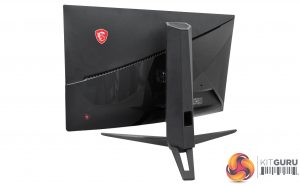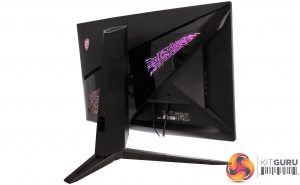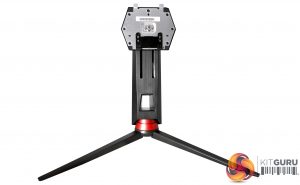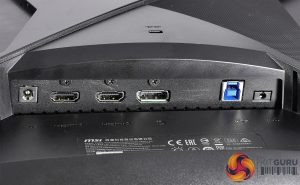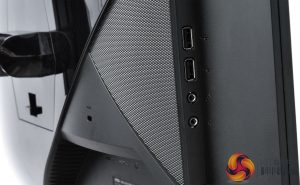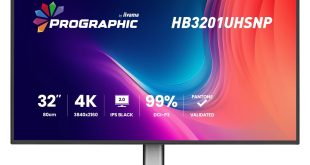As already mentioned, MSI has definitely gone for a ‘gamer’ vibe for its new Optix monitor series. Curvy panel to immerse you into the action? Check. Lots of matte and shiny black plastic? Check. Edgy stand and base with sharply-angled metal legs that make it look like an Decepticon transformed into a monitor? Check. Red accents because gamers couldn’t possibly like any other colour? Check. Adjustable RGB lighting? Double-check.
Honestly though, the overall impression is pretty good, especially since the MPG27C has one of those so-called bezel-less designs, meaning its top and side bezels are very slim and seamlessly integrated. They measure a mere 5.5mm, despite the bottom bezel thickening to around 25mm. Meanwhile, a semi-glossy screen finish helps colours to really pop.
And speaking of pretty colours, the MPG27C’s rear is beautifully adorned with a circuit-board-like, RGB backlit cut-out pattern that undulates gently with every colour of the rainbow. It’s a real shame that you can only see this if your monitor is not facing a wall, so it will probably only be enjoyed by a minority of users.
To match its looks with presentation the MSI Optix MPG27C comes in a fully colour-printed box, which has some snazzy product shots and the important specifications clearly highlighted. Inside the display and its bits are nestled in rather a lot of Styrofoam. Along with the monitor you’ll find the external power adapter, its clover power cable, and an HDMI cable.
Next let’s talk assembly. This particular Optix comes in three parts: the main monitor chassis, stand and base. The latter two are fixed together with a single thumb-screw, after which the chassis simply clicks into that assembly, so installation is completely tool-free – unlike some, such as the recent BenQ EL2870U. It’s just as easy to deconstruct the MPG27C, as pressing a single button will let you ‘unhook’ the monitor’s main body easily. This system is similar to that used by Dell on its high-end models like the UltraSharp 24 InfinityEdge U2417H, and it’s one we’re particularly fond of, so bravo MSI.
Build quality is pretty decent all-round. The monitor’s body combines a variety of different plastics and finishes yet manages to feel solid without any of the creak we find on some chassis. The stand also holds up well, although there is just a little give as it’s mostly hollow around what appears to be a metal core. Meanwhile, the all-metal foot with its long legs could be used as an effective weapon during the zombie apocalypse.
Our one real complaint is that the stand takes a lot of room on your desk; we’ve never had a monitor on our test bench that required this much leg-room, especially not one of the 27in variety. So just make sure you have the required 36cm of clearance behind your preferred keyboard position, or else you may need to look into VESA mounting on the wall or a third-party stand solution. Luckily, the MSI Optix MPG27C’s legs are quite thin, meaning at least you can arrange items around and between them easily.
MSI Optix MPG27C Adjustability and Connectivity
Somewhat unusually, the Optix MPG27C offers every adjustment except pivot – though arguably the latter might not make as much sense on a curved display. However, you do get a decent amount of height adjustment, raising the base from 7.5 to 19.5cm from the desk. There’s also the mandatory tilt and a very generous amount of swivel. And – as already mentioned – VESA mounting is available in case you want to use an even more flexible solution.
The main connectivity is down-facing, which can make things a bit of a pain to plug in due to the aforementioned lack of pivot. This is exacerbated by the lack of clear icons indicating where to plug the cables in, but at least the amount of swivel helps to make things a little accessible. We were also happy to find twin USB 2.0 ports from the integrated hub, along with headphone and microphone jacks, all within easy reach at the monitor’s left side.
Though there’s no dedicated headphone hook, as found on some gaming monitors like the AOC AGON AG271UG, you can hang your headphones over the top of the stand and, again, use swivel to make them easy enough to nab.
Along the MPG27C’s rear, you’ll find the round power jack, twin full-size HDMI 1.4 ports, a DP (DisplayPort) 1.2 connector, the blue USB 2.0 input (yes we thought it was version 3.0 at first too) to feed the hub, and another 3.5mm headphone jack. Above those ports there’s also a Kensington lock slot. While some might be disappointed with the ‘old’ versions of HDMI and DP, there’s really no need for anything higher on a Full HD, non-HDR display. However, those USB ports should really be USB 3.0, rather than 2.0.
 KitGuru KitGuru.net – Tech News | Hardware News | Hardware Reviews | IOS | Mobile | Gaming | Graphics Cards
KitGuru KitGuru.net – Tech News | Hardware News | Hardware Reviews | IOS | Mobile | Gaming | Graphics Cards


